In the exciting world of 3D printing, there’s more than just innovation and invention; there’s also immense fun and creativity. What could be a better testament to this than 3D-printed cats? Whether it’s an intricately detailed figurine of your favorite feline or a plaything for your pet, 3D printing technology has opened up endless possibilities for cat lovers and enthusiasts.
This article will guide you through the fascinating universe of 3D-printed cats, exploring everything from playful toys to protective armor. Whether you’re curious about how to 3D print cat toys or you’re interested in the design process for 3D printed cat armor, we’ve got you covered.
3D Printed Cat: An Artistic Expression
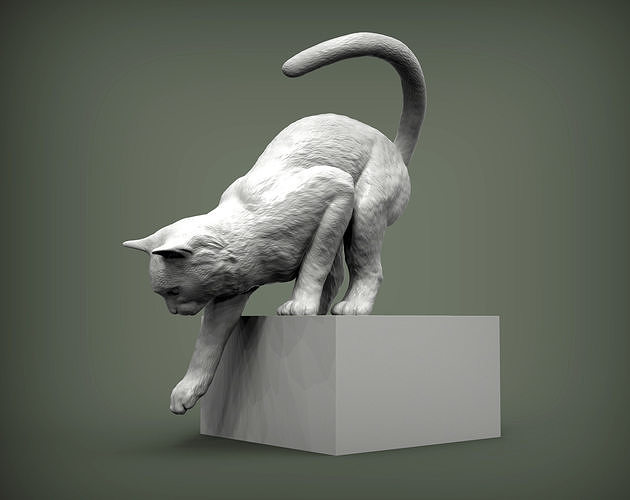
3D printed cat
3D printing service is revolutionizing the way we approach art, enabling creators to materialize intricate and precise designs with relative ease. In the world of feline aficionados, 3D printed cats have found a special place, with numerous artists using this technology to capture the charm and elegance of our furry friends.
Artistic 3D printed cats range from lifelike figurines replicating specific breeds to more abstract renditions that reflect an artist’s unique interpretation. These objects can be made from various 3D printing materials, including plastic, resin, or metal, depending on the desired finish and purpose. They can be painted, polished, or even left with a raw finish for a more rustic look.
Here are some types of artistic 3D printed cats:
- Lifelike Figurines: These designs aim to replicate real-life cats, focusing on anatomical accuracy and details like fur texture or individual whiskers. They can be specific to a breed or replicate a pet.
- Stylized Interpretations: These figurines incorporate artistic elements that may distort or exaggerate certain features for a unique aesthetic appeal.
- Themed Creations: These designs integrate cats into broader themes, such as fantasy or folklore, creating a narrative around the figurine.
- Abstract Forms: Some artists use the form of a cat as a base for abstract designs, exploring shapes, colors, and textures without aiming for realism.
Table 1: Comparing Different Types of 3D-Printed Cats
| Type | Characteristics | Materials Used |
|---|---|---|
| Lifelike Figurines | Anatomically accurate, breed-specific | Plastic, Resin, Metal |
| Stylized Interpretations | Exaggerated features, unique aesthetic | Plastic, Resin, Metal |
| Themed Creations | Cats integrated into broader themes | Plastic, Resin, Metal |
| Abstract Forms | Exploration of shapes, colors, textures | Plastic, Resin, Metal |
The Joy of Play: 3D Print Cat Toy
Cats are known for their playful nature, and interactive toys play a crucial role in their mental and physical stimulation. With 3D printing, customizing toys to cater to a cat’s specific preferences has become possible, leading to more engaging and enjoyable playtimes.
The process of creating a 3D-printed cat toy involves designing the toy using CAD software, selecting an appropriate material (usually a sturdy, non-toxic plastic), and then printing it using a 3D printer. Safety is paramount when creating these toys, as they need to withstand a cat’s sharp claws and teeth, and should not have small parts that could be easily swallowed.
Table 2: 3D printed cat toys that have gained popularity
| Type | Description |
|---|---|
| Balls | 3D-printed balls with intricate patterns that can be filled with small bells or objects to create sound. |
| Puzzle Feeders | 3D-printed complex puzzle feeders can stimulate a cat’s problem-solving skills and slow down rapid eaters. |
| Catnip Toys | 3D-printed toys with compartments for catnip that can provide an irresistible attraction for cats. |
| Interactive Stands | 3D-printed stands with dangling objects or moving parts that can keep cats entertained for hours. |
Taking Creativity to the Next Level: 3D Printed Cat Armor
As cat owners become more innovative and creative with 3D printing, one product that’s emerged as a popular trend is 3D-printed cat armor. While more novelty than functional, these costumes can offer an amusing way to engage with pets while also providing unique photo opportunities.
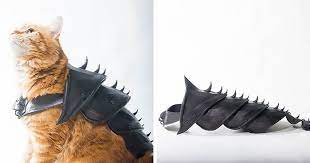
3D-printed cat armor
Designing a 3D-printed cat armor involves creating a model that is not only visually appealing but also comfortable and safe for the cat. It should be lightweight, free of sharp edges, and fit the cat well. Often, it’s composed of multiple pieces that are assembled after printing to allow movement.
Here are a few examples of 3D-printed cat armor;
Table 3: Examples of 3D Printed Cat Armor
| Type of Armor | Characteristics | Considerations |
|---|---|---|
| Dragon Armor | Scales, wings | Must be lightweight, safe |
| Knight Armor | Medieval-style, shield | Must be lightweight, safe |
| Robot Armor | Futuristic, sleek design | Must be lightweight, safe |
Safety and Comfort: Keys to 3D Printed Cat Armor
Safety and comfort are crucial when designing and printing 3D cat armor. The armor should not restrict the cat’s movement or cause discomfort. The materials used should also be non-toxic and safe for pets.
Bulleted List:
- Safety: Ensure the armor is free from sharp edges or points that could injure the cat.
- Comfort: The armor should not restrict the cat’s movement.
- Size: Measure your cat accurately to ensure the armor fits well.
- Material: Use non-toxic, pet-safe materials for printing.
Try Prolean Now!
Customized Feline Experiences: Can I 3D Print Cat Toys?
The beauty of 3D printing is that it allows customization to suit the needs of specific users – or in this case, cats. It is entirely possible to 3D print cat toys, tailored to your feline friend’s preferences.
Toys can be designed to appeal to the cat’s hunting instincts, incorporating elements that move, make noise, or contain catnip. Always ensure the safety of the toy by using non-toxic materials and avoiding small parts that could pose a choking hazard.
Table 4: Considerations for 3D Printed Cat Toys
| Consideration | Explanation |
|---|---|
| Safety | Use non-toxic materials, and avoid small parts that a cat could swallow. |
| Durability | The toy should be robust enough to withstand a cat’s claws and teeth. |
| Interactivity | Toys should stimulate a cat’s natural instincts. |
| Cleanability | The toy should be easy to clean for hygienic purposes. |
With these considerations in mind, you can leverage the flexibility of 3D printing to create unique toys that keep your cat entertained and engaged.
From Idea to Reality: The 3D Printing Process for Cat Items
In creating 3D printed objects, the process generally involves three main steps: designing your 3D model, preparing the 3D printer, and printing your design.
In the design phase, you can either create your own unique design using software like Tinkercad or Fusion 360 or opt for pre-made models from online platforms like Thingiverse or MyMiniFactory.
Preparing the 3D printer is the second step, which involves choosing the right type of filament – usually PLA for pet items due to its non-toxic nature, and setting up the printer. It’s crucial to ensure the print bed is level and the extruder is at the right temperature.
Lastly, the printing process begins. Depending on the complexity of your design, this could take from a few hours to several days. It’s crucial to monitor the print occasionally to ensure everything runs smoothly.
Here’s a detailed table summarizing the process:
Table 5: Steps in creating a 3D-printed cat
| Step | Process Details | Tips |
|---|---|---|
| Designing Your 3D Model | Creating a digital model of the item using 3D modeling software | Use software like Tinkercad or Fusion 360 for original designs OR Utilize pre-made models from online platforms like Thingiverse or MyMiniFactory |
| Preparing the 3D Printer | Choosing the right filament and setting up the printer | Use non-toxic materials like PLA when printing items for pets AND Ensure the print bed is level and the extruder is at the right temperature |
| Printing Your Design | Loading the design into the 3D printer and starting the printing process | Print time can range from a few hours to several days depending on the complexity of the design. Additionally, It’s essential to monitor the print occasionally to ensure everything is running smoothly |
Important Considerations: Is 3D Printing Safe for Cats?
When creating 3D-printed items for cats, safety should always be a top priority. This includes considering the type of material used for printing, the design of the item, and how the item will be used by the pet.
1. Material Safety
Most 3D printers use plastic filaments like ABS or PLA. Of these, PLA is generally the safer choice for pet items as it is non-toxic and biodegradable.
- PLA (Polylactic Acid): This material is derived from cornstarch, making it non-toxic and biodegradable.
- ABS (Acrylonitrile Butadiene Styrene): ABS can release harmful fumes during the printing process, and it’s not as safe for pets as PLA.
2. Design Safety
The design of the item should also ensure safety. Avoid small parts that could be chewed off and swallowed, and ensure that there are no sharp edges that could injure the cat.
Table 6: Design Safety Considerations
| Consideration | Why It’s Important |
|---|---|
| Small Parts | These can be a choking hazard. |
| Sharp Edges | These can cause injury. |
| Size of Item | Ensure the item is appropriately sized for your cat. |
Step into Creativity: Designing Unique 3D Printed Cat Toys
When it comes to creating cat toys, 3D printing allows you to push the boundaries of traditional design. Whether it’s a ball with a unique pattern or a complex puzzle toy, you can bring your wildest ideas to life. Here are some ideas:
1. Cat Toy Balls with Bells Inside
One popular type of 3D-printed cat toy is a hollow ball with a small jingle bell inside. These toys are not only fun for cats to play with, but also provide exercise as they chase after the ball. You can choose a simple design or get creative with intricate patterns and shapes to make the toy even more appealing to your furry friend.
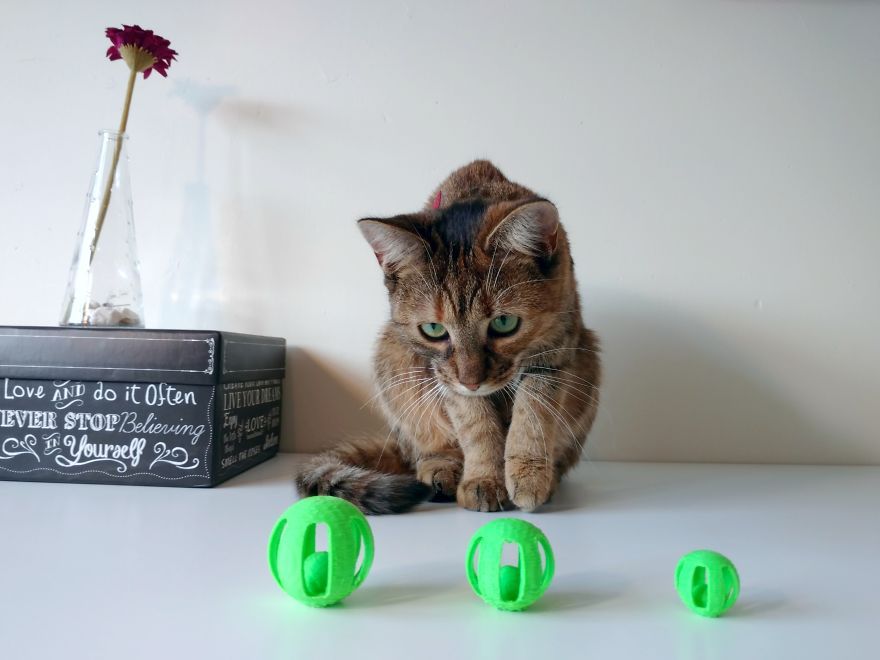
Cat Toy Balls with Bells Inside
2. Puzzle Toys for Mental Stimulation
Cats are intelligent creatures and need mental stimulation to stay healthy and happy. 3D printing allows you to create puzzle toys that can keep your cat engaged for hours. These toys can be designed to dispense treats as the cat interacts with them, providing both mental stimulation and a tasty reward. You can create a variety of designs, from simple mazes to more complex puzzles that require problem-solving skills.
- Endless Possibilities with 3D Printing: With 3D printing, you’re only limited by your imagination. From geometric designs to cat-themed shapes, you can create toys that are unique and tailored to your cat’s preferences. You can also experiment with different materials to find the perfect texture and weight for your cat’s toys.
- Interactive Toys for a Happy Cat: Interactive toys are a great way to keep your cat active and entertained. You can create toys that offer mental stimulation, such as puzzle toys that dispense treats when solved. You can also create toys that encourage physical activity, such as balls that are designed to roll and bounce in unpredictable ways.
Overall, 3D printing offers endless possibilities for creating unique and engaging toys for your cat. Whether you want to provide mental stimulation, physical exercise, or just some fun playtime, you can design toys that are tailored to your cat’s needs and preferences.
Armor Up: Creating 3D Printed Cat Armor
If you’re feeling particularly adventurous, why not design a set of 3D printed armor for your cat? This could range from a simple harness to a full suit of medieval knight armor.
- Simple Harnesses
You could start with a simple harness design that fits comfortably around your cat’s body. Remember, comfort should be paramount in any wearable design for pets.
- Full Body Armor
For the ultimate in feline fashion, consider designing a full body armor set. Remember, this should be used for fun photoshoots and not for prolonged periods, as it may be uncomfortable for your cat.
- Comfortable Design: Whether it’s a harness or full body armor, always prioritize your cat’s comfort and ensure the design doesn’t restrict movement.
- Lightweight Materials: Use lightweight PLA filament to avoid creating a heavy armor that could be burdensome for your cat.
Summing Up
3D printing is an innovation that’s rapidly changing many aspects of our lives, from manufacturing to the pet industry. The 3D-printed cat phenomenon is a shining example of how creativity and technology can coexist and open up new realms of possibilities. This article has walked you through the process of creating 3D-printed cat toys and novelty items, from the concept stage right through to the finished product.
The advent of 3D printing technology has made it easier than ever to create unique, personalized items that cater to our pets’ unique needs and preferences. Whether you’re crafting a whimsical cat figurine, a custom plaything, or even a suit of cat armor, the power is in your hands. By harnessing the potential of 3D printing, we can provide our feline friends with safer, more engaging toys and accessories.
Remember, when crafting items for pets, safety should always come first. Always choose pet-friendly, non-toxic materials and avoid small parts that could be a choking hazard. With the right approach and a touch of creativity, you can bring joy to your pet’s life with your one-of-a-kind 3D-printed creations.
FAQs
What is a 3D-printed cat?
A 3D-printed cat can refer to a cat figurine created using 3D printing technology. It can also refer to various cat-related items such as toys and accessories made through 3D printing.
Can I make my own 3D-printed cat toys?
Yes, you can create your own 3D-printed cat toys. All you need is a 3D printer, suitable filament (usually non-toxic PLA), and a 3D model. You can design your own model or download pre-made models from online platforms.
What kind of filament should I use for 3D-printed cat toys?
PLA (polylactic acid) is a commonly recommended filament for 3D-printed cat toys because it’s non-toxic and biodegradable. However, always check with your filament supplier to make sure it’s safe for pet items.
Are there any safety concerns with 3D-printed cat toys?
As with any pet toy, there are potential safety concerns. These include the risk of the pet swallowing small parts, sharp edges that could cause injury, and the use of potentially toxic materials. Always monitor your pet when they’re playing with new toys and regularly inspect the toys for any damage.
Can I 3D print a cat armor?
Yes, you can 3D print cat armor. There are many designs available online that you can download and print. However, always consider your cat’s comfort and safety. It’s also crucial to measure your cat correctly to ensure a proper fit.

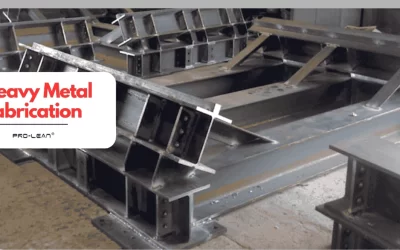
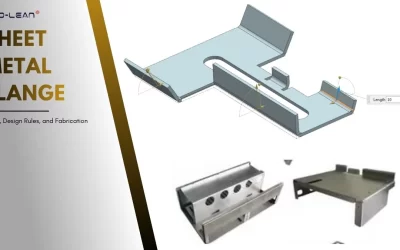
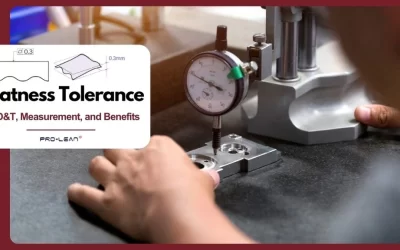
0 Comments